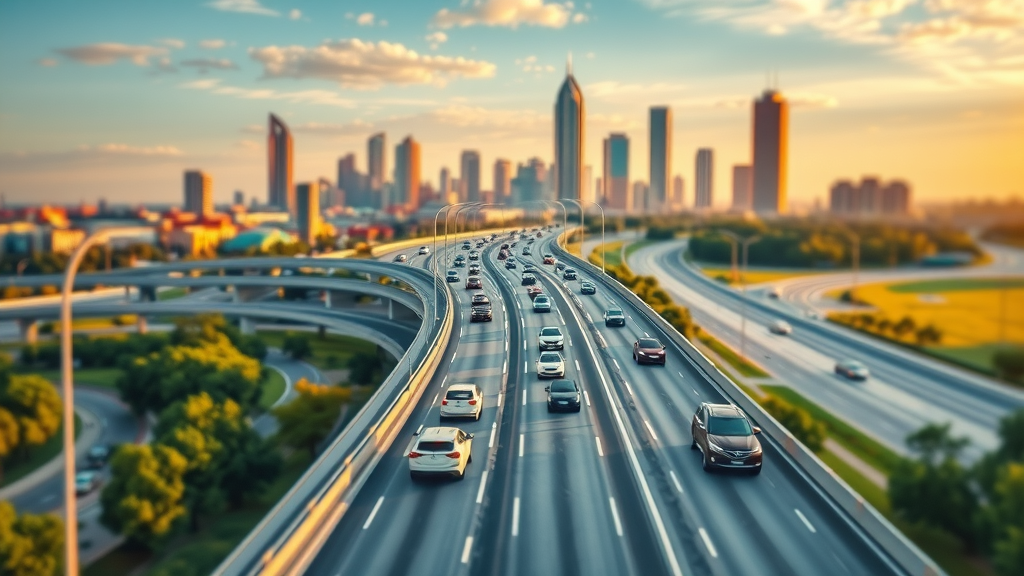Did you know Dallas spends billions on highway construction each year—and yet traffic delays are a daily headache for commuters? As the city of Dallas races to keep up with booming growth, construction cones and detours have become part of daily life, reshaping everything from your morning commute on the Dallas North Tollway to how small businesses operate. But these projects promise more than inconvenience—they’re transforming the city’s future infrastructure. Read on to discover how you can sidestep the worst delays, understand what’s behind the lane closures, and prepare for the road ahead.

Did You Know? Dallas Highway Construction Projects Cost Billions Annually
Every year, Dallas highway construction projects demand an astonishing multi-billion dollar investment. The sheer scale is enough to make any taxpayer pause—and for commuters, the financial commitment becomes impossible to ignore when you’re idling behind rows of orange cones. Projects like the expansion of the Dallas North Tollway, improvements along Church Road, County Line, and strategic updates to city streets are “funded with SPLOST (Special Purpose Local Option Sales Tax) funds,” and will continue to shape the city’s future. These investments aim to support the city of Dallas’ ever-growing population and economy by easing bottlenecks and improving city street connectivity.
For those navigating the Dallas North Tollway or confronted by the latest detour map, understanding where your money is going can ease some frustration. With the design phase for several major construction projects underway, including the east project at Coit Road and the Rayburn Tollway connector, transparency becomes vital. Regular updates and detailed detour maps are helping residents make sense of frequent lane closures and construction signs that dot the region’s highways and frontage roads.
Ultimately, these billion-dollar investments aren’t just about new lanes and smoother pavement—they’re meant to futureproof Dallas. As expansion projects move forward, each phase, whether recently finished or ongoing, is evaluated by how well it addresses congestion and enables the city to move forward efficiently. Staying informed about what’s changing on the Dallas North Tollway and adjacent arterials is the first step in avoiding unnecessary headaches.
Why Staying Informed About Dallas Highway Construction Is Vital for Commuters
Staying up to date on Dallas highway construction is more than just a convenience—it’s a necessity for anyone hoping to arrive on time and in good spirits. Major highways like the Dallas North Tollway are experiencing phases of closures, exit ramp changes, and speed limit adjustments that impact traffic daily. The city of Dallas works hard to share updates, yet the fast pace of new construction means that project timelines and detour maps can change rapidly. Commuters who check real-time updates, download detour maps, and listen to traffic reports stand a much better chance of avoiding the worst of the delays.
Beyond personal commutes, these changes ripple throughout the region: delivery drivers, public transport routes, school buses, and emergency responders all rely on timely information. The design phase began more than a year ago on some projects, but the alternating lane closures, revised turn lanes, and new exit ramp locations add up to a constantly shifting road environment. If you live or work near Church Road or County Line, regular monitoring of construction projects is critical—you can’t assume what was open yesterday will still be open today.
- You’ll discover the latest updates on Dallas highway construction projects, understand how construction impacts the Dallas North Tollway and other major routes, and get expert tips to avoid traffic snarls.
Current Dallas Highway Construction Hotspots and Their Effects
The hotspots of Dallas highway construction are not just frustrating but reshaping daily patterns for thousands. From the iconic Dallas skyline to the northside of the metro area, roadwork has become a staple along nearly every major route—nowhere more so than on the Dallas North Tollway and surrounding arterials. Church Road, County Line, Arapaho, and Frankford stand out as notorious pinch points, with the impact felt both by daily commuters and local businesses relying on foot traffic and deliveries.
The latest detour maps highlight how each construction project ripples across city streets and neighborhoods. Lane closures, changes to the turn lane system, and revised speed limits can cause unpredictable slowdowns, especially during peak hours. Alternate routes can sometimes add miles and minutes—or even hours—to regular commutes. With the city of Dallas charting future expansions and updating traffic management plans, the current disruptions won’t vanish overnight, but understanding the main problem points puts you in the driver’s seat to plan ahead.
From the east project at Shiloh Road to revamped frontage roads near Coit Road, locals are forced to adapt constantly. The process is complex: each stage is carefully scheduled to minimize overall disruption, but the last-minute changes inherent in any large construction project mean it pays to be vigilant. Most importantly, immediate inconveniences are counterbalanced by the promise of long-term smoother travel—not just along the north tollway but across all critical routes.
Major Delays on Dallas North Tollway: What’s Causing the Gridlock?

Gridlock on the Dallas North Tollway has become a daily ordeal, with delays stretching far beyond morning and evening rush hours. The reason? Expansion projects targeting capacity upgrades, direct connector improvements, and crucial overpass repairs have required frequent exit ramp closures, fluctuating turn lane designs, and periodic reductions in the posted speed limit. These changes aim to alleviate longstanding bottlenecks but have created fresh headaches during their rollout.
Commuters are especially impacted at key junctions—where Coit Road, County Line, and Church Road intersect with the tollway—and where city plans have prioritized moving forward with phased construction even during peak travel times. Real-time navigation apps can help, but detour maps occasionally lag behind fast-moving construction updates. Weekend and nighttime closures often catch drivers off guard, and alternative frontage roads sometimes become just as congested as the tollway itself.
Many frustrated drivers have noted that the unpredictability of the lane closures can make it nearly impossible to plan an efficient route. The complex interplay between the city’s desire for continuous progress and the logistical hurdles of managing such large construction projects assures North Dallas residents that this challenge is more marathons than sprint. For now, patience and preparation—like checking for the most current detour map—remain commuters’ best allies.
Church Road and County Line Challenges: Local Impacts of Dallas Highway Construction
For neighborhoods surrounding Church Road and County Line , the ongoing Dallas highway construction introduces daily disruption on multiple fronts. Not only are turn lanes and frontage road accesses regularly reconfigured, but delivery trucks, school buses, and local businesses rely on precise access to city streets that can shift suddenly. Residents and business owners recommend checking official social media and downloading the current detour map each morning to avoid unexpected blockages from a new construction project or overnight phase.
Some business owners report lost revenue when delays and lane closures discourage customers from visiting or cause delivery setbacks. Others, adapted by investing in visibility—signage, special offers, and stronger social media presence—aiming to attract foot traffic despite construction fences and detour maps. For parents, adjusting school drop-off routines and teaching teenagers how to navigate temporary turn lane setups is now a rite of passage in Dallas North.
Local urban planners underscore the balancing act involved: connectivity improvements are essential, but frequent recalibration between construction goals and community needs is non-negotiable. Projects funded with SPLOST funds or city bonds offer reassurance that long-term gains are prioritized, but short-term headaches often feel overwhelming. Those living on or near County Line and Church Road know: being proactive about route planning is key to minimizing stress during this massive infrastructure overhaul.
| Location | Projected End Date | Primary Impact | Alternate Routes |
|---|---|---|---|
| Dallas North Tollway (DNT) at Arapaho | Late 2024 | Lane closures, speed limit changes | Church Road, Coit Road |
| County Line & Church Road intersection | Mid 2025 | Turn lane reconfigurations, detours | Main St, Frankford |
| Sam Rayburn Tollway Direct Connector | Early 2025 | Exit ramp changes, traffic detours | Shiloh Road, Rayburn Tollway |
| East Project - Coit Rd./DNT Frontage Roads | Fall 2025 | Frontage road restrictions, altered access | Frankford, City of Dallas streets |
How Dallas North Tollway Expansion Alters the Commute
The Dallas North Tollway expansion is more than a simple addition of lanes or new paint on the pavement—it’s a transformation that affects every commuter and neighborhood it touches. The stated goal is to “keep Dallas moving forward” by addressing congestion points, opening up new west and east project connections, and supporting the long-term vision of city planners. Yet the actual day-to-day changes are felt most by those navigating the altered exit ramps, new speed limits, or temporary frontage road closures.
Residents and commuters using intersections like Church Road, County Line, Arapaho, and Frankford are finding that traditional routes may now be interrupted by redirected traffic, new signage, or entirely blocked turn lanes. While alternate frontage road detours can help in some cases, the reality is that every small adjustment—an added turn signal, a shifted detour map, an adjusted light cycle—adds cumulative minutes to travel. The project’s timeline, informed by feedback, city funding, and the careful sequencing of each phase, means these short-term adjustments are here for months or even years before benefits are locked in. Still, for those willing to adapt and seek out the latest information, ways to minimize daily hassle abound.
Over time, many hopes rest on the tollway expansion’s capacity to streamline not just commutes, but local economic growth. As the design phase began and construction projects multiplied, city planners promised that eventually these upgrades would reduce bottlenecks on the north side and create better connections to main arteries—such as Sam Rayburn Tollway and beyond. Until then, being in-the-know can mean the difference between a quick highway experience and an hour-long standstill.
Dallas North Tollway: More Than a Commuter’s Artery
The Dallas North Tollway serves as the lifeblood for not only city commuters but entire neighborhoods seeking access to the rest of Dallas and its surroundings. The current expansion is about more than easing traffic; it is redefining city connectivity and how Dallas residents access jobs, schools, and community spaces. Closures at major intersections, changes to turn lanes, and shifting traffic flows between major points like Arapaho and Frankford alter more than just commuting times—they ask people to rethink their city’s geography and the routines they’ve cultivated for years.
- Key intersections affected by the north tollway expansion: Church Road, County Line, Arapaho, Frankford
“The Dallas North Tollway expansion has reshaped neighborhood connectivity and forced many to rethink their daily routes.” – Local Urban Planner
The cumulative effect of these upgrades is already visible. New turn lane configurations, modernized exit ramps, and frontage road improvements offer the promise of greater efficiency down the line. For now, however, every revision—whether in the form of a download detour map notice or a realignment of the city street grid—reminds locals that their patience is as much an investment as the billions spent on the construction project itself.
Dallas North: The Broader Vision of City Infrastructure

For Dallas, highway construction is a key pillar of its vision for future growth . While daily frustrations dominate headlines, the city of Dallas views these projects as laying the groundwork for decades of prosperity, mobility, and urban development. The design phase began years ago with the request for community feedback, and ever since, the city has juggled complex priorities: expanding north tollway capacity, integrating new direct connector ramps, and planning for sustained population growth—all funded with a mix of SPLOST funds, bonds, and public-private partnerships.
While construction projects on the Dallas North corridor and nearby city streets inevitably bring daily headaches, city planners and urban designers see the long-term gains: improved business access, reduced gridlock, and support for robust, modern transportation systems. The integration of City of Dallas transit initiatives and state highway infrastructure means these projects will affect lifestyles for generations—improving everything from residential commutes to commercial logistics and even eco-friendly transit options. The challenge ahead is ensuring day-to-day disruption is matched by communication and flexibility, making the end result worth the wait. For now, urban planners urge everyone to stay engaged and keep voicing their needs during each phase of development.
Integrating Dallas Highway Construction With North Texas Growth
The explosive growth of North Texas has transformed infrastructure planning into a continuous process. Dallas highway construction isn’t just a local project—it’s about linking the city to a regional hub spanning from Sam Rayburn Tollway in the north to southern commercial centers. As the design phase for old and new expansions began, feedback was sought from all quarters to ensure the city’s strategic vision aligned with the realities of urban sprawl, economic development, and sustainable transit solutions.
City of Dallas officials, responsible for managing everything from expansion projects to selecting alternate routes on detour maps, face mounting pressure to deliver results quickly and efficiently. Whether it’s North Side neighborhoods near County Line or bustling corridors along Shiloh Road and Arapaho, the city’s commitment to keeping Dallas moving forward requires a blend of expert planning and continuous public involvement. With every project funded and each SPLOST dollar accounted for, transparency becomes as important as construction progress itself.
Ultimately, integrating highway construction with area growth means ensuring each newly opened turn lane or direct connector supports both present needs and future aspirations. That means factoring in everything from city street landscaping to commercial zoning, school access, and promoting flexible transportation habits—all to ensure the north tollway corridor becomes a true backbone for Dallas North prosperity.
Long-Term Benefits vs. Daily Headaches
While the daily headaches of lane closures and detour maps are all too real, long-term benefits of Dallas highway construction can’t be overstated. When construction projects began along the north tollway or at vital city street intersections, city leaders promised improved overall traffic flow, greater access to the city center, and economic growth for the north side districts. The challenge? Ensuring that the day-to-day disruptions don’t dampen public support for projects that will benefit Dallas for decades to come.
As the project is funded and each phase began, consistent communication and clear detour maps have become crucial. Businesses, residents, and visitors alike depend on updates to change routines—whether using alternate routes, shifting commute times, or participating in public feedback sessions to voice concerns and seek accommodations. The short-term sacrifices asked of commuters and business owners are meant to be offset by a revitalized, more accessible city in the future.
The urban planning world refers to this process as “building for future generations,” and Dallas is no exception. If the city continues to engage, update, and adapt at every stage of construction, the headaches today are a down payment on the thriving, interconnected metroplex that’s rapidly taking shape.
Hidden Costs of Dallas Highway Construction: Economic, Environmental, and Social
Dallas highway construction comes with costs beyond the price tag: lost business days, environmental impacts, and even stress for those living near ongoing projects. The North Tollway, as well as surrounding city streets, host a revolving set of construction projects funded with SPLOST funds or city bonds, all of which require balancing financial investments with social and environmental responsibility. Local air quality is impacted by dust and idling vehicles, while noise pollution and altered pedestrian access remain persistent community concerns.
On the economic side, lane closures, redesigned frontage roads, and major detour map adjustments often mean lost sales and delayed deliveries for businesses. Small retail and restaurants near main corridors—especially around Church Road, County Line, and along the east project by Coit Road—are often hit hardest. Adaptation becomes the order of the day as store owners work to adjust operations and maintain customer flow during extended construction phases, sometimes with creative results like drive-thru solutions or special promotions for those navigating the chaos.
Communities along the highway expansion corridor are also learning to cope with lifestyle changes: longer school commutes, reduced recreational access, and a need to plan daily routines around the ever-changing detour map. The hope is that the expansion projects, once completed, will yield smoother travel, less congestion, and better access to local resources—but getting there remains a communal, often stressful journey.
North Tollway Workarounds: Cost Implications for Drivers and Businesses

The search for effective workarounds to the Dallas North Tollway construction can come at a significant cost. For drivers, new alternate routes mean added mileage, fuel expenses, and, not uncommonly, time missed at work or family events. For employers and logistics firms along city streets intersected by the tollway or east project detours, delivery schedules are disrupted and just-in-time inventory systems can falter. Every change to an exit ramp or turn lane potentially triggers a domino effect—impacting dozens of delivery routes and driving up costs citywide.
Small businesses located on or near heavily affected corridors like Church Road, County Line, or Arapaho often see a direct drop in customer visits. With main frontage roads blocked or flagged as “road work, find alternate route,” even loyal clients may decide the detour map just isn’t worth the trip. While some companies have adapted by adjusting operating hours, offering delivery incentives, or boosting online engagement, the challenges remain acute.
The message from the business community is consistent: the sooner clear communications and predictable detour options can be offered, the better. With each additional phase of the expansion project, more businesses will need support—whether that’s through targeted relief programs, marketing boosts, or simply a commitment to keeping city streets and turn lanes as navigable as possible. The long-term health of the city’s economy is intrinsically tied to how painlessly these construction projects are managed.
Effective Strategies for Dodging Dallas Highway Construction Delays
Preparation and flexibility are your best tools for navigating around Dallas highway construction delays. With congestion, detours, and unplanned lane closures creating daily roadblocks, successful commuters have learned to adapt quickly. Whether it’s using real-time traffic apps to monitor closures, adjusting commute times to off-peak hours, or relying on well-publicized alternate routes such as Church Road and County Line, proactive tactics can pay off in time saved and stress reduced.
Community resources continue to grow. The city of Dallas offers project websites and notification systems—sign up for these to access the most up-to-date detour maps and project completion forecasts. Many drivers find benefit in carpooling or using public transit programs during the heaviest construction. Frequent updates, combined with crowd-sourced data from navigation apps, can offer vital alternate turn lanes or unexpected city street detours, keeping travel as efficient as possible despite the ongoing projects.
For those living or working along major construction corridors, creating a daily “check before you drive” habit is invaluable. Encourage your network—family, colleagues, and clients—to do the same. The more people who coordinate and cooperate around changing conditions, the more efficiently Dallas can move forward even while construction is at its peak.
- Top Tips to Stay Ahead of Dallas Highway Construction:
- Use real-time traffic apps
- Adjust commute times
- Explore alternate routes like Church Road and County Line
- Carpool to reduce congestion
Community Voices: How Dallas Drivers Are Adapting to Highway Construction
- Personal stories from north tollway and Dallas North commuters

Community feedback has become a cornerstone of how Dallas highway construction projects evolve. Many commuters stationed near the north tollway, who once dreaded the commute, have developed new habits: sharing real-time updates with neighbors, forming informal carpool networks, and becoming local experts in city street and backroad detour maps. Stories abound of friends texting each other when a fresh lane closure appears, or of neighbors teaming up to “scout” new routes before the workday begins.
Likewise, businesses have joined in—offering special discounts to customers who show they’ve arrived via a detour, or providing quick download detour map guides on social media. These initiatives foster a unique sense of community resilience, where adapting to construction isn’t just an individual problem but a collective project. Dallas North residents are keenly aware that flexibility and information-sharing have become essential survival tools, building connections that could endure long after the last traffic cone is gone.
What’s clear is that the disruptive nature of the construction project is offset somewhat by the creativity and determination Dallas locals show in tackling the challenge. Every adaptation—however small—brings the city of Dallas a little closer together.
What’s Next for Dallas Highway Construction? Upcoming Projects & Deadlines
The Dallas highway construction boom isn’t fading anytime soon. City announcements and planning documents make it clear: more phases are scheduled for both the Dallas North Tollway and adjacent major arterials. Each project on the calendar brings promises of smoother commutes, enhanced safety, and greater economic development—but also demands patience as new waves of detour maps and lane closures roll out. By looking ahead, commuters and business leaders can anticipate when to expect major milestones and plan their travel habits accordingly.
Planned construction highlights for the next 12-24 months include expanded frontage roads on the east project by Coit Road, the completion of direct connectors along Rayburn Tollway, and further prioritization of main city street improvements. The goal? An interconnected highway system capable of supporting Dallas’s unprecedented growth. With estimated completion dates for key projects posted on city websites and local news, planning ahead is more manageable, though delays are always possible due to weather or funding shifts.
In this dynamic environment, the importance of flexible travel plans, prompt access to updated detour maps, and a willingness to adapt daily routines will remain paramount. The future of Dallas highway construction is bright but requires constant vigilance and community involvement.
Planned Expansions on Dallas North Tollway and Adjacent Arterials
The current project list for Dallas North Tollway and surrounding arteries includes more than just widening lanes. Expect new direct connector ramps, integrated turn lanes, digital signage for real-time updates, and redesigned intersection approaches on streets such as Church Road and County Line. The design phase for several projects has recently been updated, incorporating public suggestions and safety feedback. Every effort is being made to minimize redundant delays and improve communication via download detour map platforms and neighborhood outreach sessions.
Progress on the construction project timeline is regularly published, offering drivers the chance to minimize disruptions and maximize efficiency by timing travel around scheduled closures. For businesses, these schedules allow for advanced logistics planning, supply chain adjustments, and community outreach to maintain vital connections even during peak construction activity. If executed as planned, these expansions promise not just relief from current congestion but a transformative leap forward in metro Dallas’s mobility infrastructure.
An ongoing commitment to transparency will be the linchpin for public trust—ensuring each phase is reported to the city of Dallas’s online portals, updated frequently, and made accessible on easy-to-read detour maps. With cooperation and persistence, both city managers and commuters can look forward to steady improvements across the Dallas North corridor.
| Project | Scope | Estimated Completion |
|---|---|---|
| Dallas North Tollway Widening | Additional lanes, new exit ramps | Late 2024 |
| County Line/Church Road Redesign | Turn lane reconfigurations, signage | Mid 2025 |
| Sam Rayburn Direct Connector | Connector ramps, frontage road overhaul | Early 2025 |
| East Project (Coit Rd. Frontage Roads) | Full frontage road rebuilding | Fall 2025 |
People Also Ask: Frequently Raised Questions on Dallas Highway Construction
How can I avoid delays due to Dallas highway construction?
- Plan your commute with apps, listen to traffic reports, follow city detours, and consider flexible hours if possible.
To avoid delays, leverage real-time navigation apps that pinpoint lane closures and detours. Always consult the latest detour map before leaving home, listen to local traffic radio segments, and be open to shifting your routine to accommodate temporary congestion. If possible, explore flexible working hours or carpooling to minimize travel during the most impacted periods.
Is Dallas North Tollway closed for construction?
- Portions of the Dallas North Tollway are experiencing closures or lane reductions, often overnight or during weekends—check the latest TXDOT alerts for current status.
Full closures on the Dallas North Tollway are rare, but lane reductions and periodic overnight shutdowns, especially along expansion zones, are common. The city of Dallas and TXDOT regularly publish closure schedules—always consult these before your drive and download detour maps to stay one step ahead of any unexpected disruptions.
How do construction projects affect businesses along the Dallas North corridor?
- Reduced foot traffic, access disruptions, and delivery delays have impacted small businesses, but many adapt by adjusting hours and offering special promotions.
Highway construction along the north tollway and key city streets can significantly limit business access. Reduced visibility and detour-related parking issues lead to fewer walk-ins, but resourceful owners are responding by communicating heavily online, revising open hours, and developing creative incentives to retain customers even when travel is challenging.
What is the expected end date for the main Dallas highway construction projects?
- Most key projects are set to finish between late 2024 and 2025, though delays remain likely as work continues on the Dallas North Tollway and nearby arterial roads.
The city of Dallas aims to complete major phases along the Dallas North Tollway, Church Road, County Line, and the east project by Coit Road by the end of 2025. Weather, material supply issues, and funding adjustments could alter these dates, so check official timelines and project updates often for the latest status.
Expert Opinions: Is Dallas North Tollway Expansion Progressing on Schedule?
“While progress is steady, unforeseen challenges always arise—community patience is as vital as project management.” – TXDOT Engineer
Most experts agree that the Dallas North Tollway expansion is moving at a respectable pace given its scale and complexity. Still, every construction project of this magnitude faces challenges—from surprise soil conditions to funding approvals and supply chain delays. Open communication, community feedback, and adaptability are critical for success. Public engagement remains a major factor in keeping the project aligned with expectations, and ongoing patience is appreciated.
Each milestone—whether it’s breaking ground on a new section of frontage road, opening a completed direct connector, or reconfiguring turn lanes—is a testament to both diligent project management and public flexibility. The city’s emphasis on updating detour maps, holding outreach sessions, and listening to citizens is shaping a stronger partnership between those who build the highways and those who use them every day.
A Look Ahead: Will Dallas Highway Construction Deliver on Its Promises?
Balancing Growth and Accessibility for a Better Dallas North
The broader challenge facing Dallas highway construction isn’t just finishing projects on time—it’s achieving the delicate balance between rapid growth, neighborhood accessibility, and long-term quality of life. With projects funded by a blend of city and SPLOST sources, the city of Dallas is betting that short-term frustration will pave the way for decades of increased mobility, economic prosperity, and vibrant, connected communities. Local voices and persistent feedback will be vital to ensure project outcomes meet the real needs of drivers, business owners, and residents.
- Key takeaways:
- Dallas highway construction is both a present challenge and a future investment
- Dallas North Tollway remains the centerpiece of mobility
- Being informed saves you time and stress

By investing energy in tracking updates, sharing experiences, and participating in community outreach, residents are not only surviving the delays but actively helping steer Dallas toward a better, more accessible future.
Your Opinion Matters: Share How Dallas Highway Construction Has Impacted You
“Public feedback shapes policy. Community voices were instrumental during past phases of the Dallas North Tollway expansion.” – City Council Member
Every voice counts in shaping the ongoing evolution of Dallas infrastructure. Whether you’re stuck in daily traffic, run a business impacted by frontage road changes, or have discovered a clever detour, city officials want your input to guide current and future projects. Join local planning sessions, comment on official channels, or engage in online forums to help make Dallas highway construction more responsive and community-focused.
Your firsthand experiences, frustrations, and creative solutions help ensure the design phase for upcoming projects reflects reality on the ground—not just city planners’ intentions. The more feedback shared, the better equipped Dallas will be to keep “moving forward” with projects that benefit everyone.
Take Action: Stay Ahead of Dallas Highway Construction Changes
- Subscribe to city updates
- Connect with commuter apps
- Participate in public transportation discussions to stay proactive amid ongoing Dallas highway construction
Proactively engaging with city resources and local networks is the surest way to minimize disruption and have your needs heard. The more Dallas residents team up—sharing tips, reporting trouble spots, and weighing in on city forums—the stronger, safer, and more efficient the road ahead will become.
Summary: Navigating the Future of Dallas Highway Construction Together
- For timely updates on Dallas highway construction and north tollway developments, bookmark city resources, join local forums, and plan your travel with flexibility.
Stay informed, stay flexible, and help shape a better commute and a brighter Dallas North future—together.
Recommended Videos
- Dallas Highway Construction Explained: TXDOT’s Official Update
- How Dallas North Tollway Impacts Daily Life: Commuter Stories
- Tips for Taking Alternative Routes Around Dallas Highway Construction
- Expert Panel: Future of Dallas Infrastructure and the North Tollway
 Add Element
Add Element  Add Row
Add Row 



Write A Comment